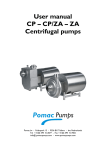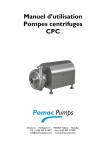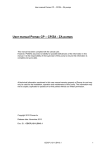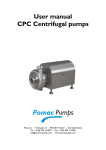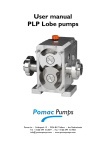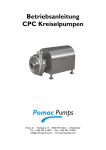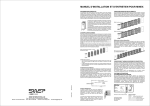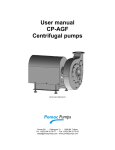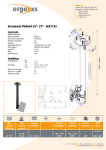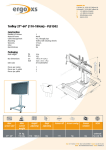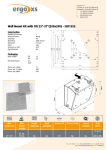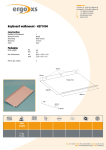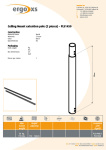Download User manual SP
Transcript
User manual SP-LR pumps Pomac bv - Feithspark 13 - 9356 BX Tolbert - the Netherlands Tel +31(0) 594 512877 - Fax +31(0) 594 517002 info@ pomacpumps.com - www.pomacpumps.com This user manual has been released d.d.:................................ and belongs to: SP-LR Pump serial number 3 capacity m /h pressure bar NPSHR m Drive, make type -1 speed voltage min / / V frequency Hz current A power kW isolation class protection class area classification Coupling, make type size IP User manual Pomac SP-LR pumps User manual Pomac SP-LR pumps This manual has been compiled with the utmost care. However, POMAC assumes no liability for possible deficiencies of the information in this manual. It is the responsibility of the buyer/user of this pump to ensure this information is complete and up-to-date. All technical information mentioned in this user manual remains property of Pomac bv and may only be used for the installation, operation and maintenance of this pump. The information may not be copied, duplicated or passed on to third parties without our written permission. Copyright 2013 Pomac bv Release date: June 2013 Doc. ID. : CE/SP-LR (1306) EN-01 CE/ SP-LR (1306) EN-01 1 User manual Pomac SP-LR pumps DECLARATION OF INCORPORATION (according to Annex II 1 B of the Machinery Directive (2006/42/EC – 1st Edition – December 2009) Pomac bv Feithspark 13 9356 BX Tolbert The Netherlands hereby declares completely under own responsibility that the pumps mentioned below: Manufacturer: Type: Execution: Materials: Pomac SP-LR KAM, KAV, IGH 1.4404 (AISI 316L) to which this declaration refers to, are in conformity with the following standards: Standards: EN-ISO 12100 parts 1 & 2 NEN-EN 60204 part 1 EN 809 The pump must not be put into service until the final machinery into which it is to be incorporated has been declared in conformity with the provisions of this Directive (2006/42/EC), where appropriate. Issued at Tolbert, 25th of June 2013 H. Poelstra Managing Director 2 CE/ SP-LR (1306) EN-01 User manual Pomac SP-LR pumps Table of contents 1. Introduction ....................................................................................................................................... 5 1.1. General information................................................................................................................... 5 1.2. Warranty .................................................................................................................................... 5 1.3. Transport and receipt ................................................................................................................ 5 1.4. Pump identification .................................................................................................................... 6 1.5. Type code ................................................................................................................................. 7 1.6. Ordering spare parts ................................................................................................................. 8 1.7. Manufacturer ............................................................................................................................. 8 2. Safety ............................................................................................................................................... 9 2.1. General information................................................................................................................... 9 2.2. Instructions ................................................................................................................................ 9 2.3. Staff ........................................................................................................................................... 9 2.4. Precautions ............................................................................................................................. 10 2.5. Changed application ............................................................................................................... 10 3. Description ..................................................................................................................................... 11 3.1. SP-RL self-priming water ring pump ....................................................................................... 11 3.1.1. Pump description ............................................................................................................. 11 3.1.2. Application area ............................................................................................................... 11 3.2. Connections ............................................................................................................................ 11 3.3. Materials .................................................................................................................................. 11 3.4. Construction designs............................................................................................................... 11 3.5. Shaft seals .............................................................................................................................. 12 3.5.1. Materials .......................................................................................................................... 12 3.5.2. Type indication code ........................................................................................................ 12 3.6. Drive ........................................................................................................................................ 12 4. Installation ...................................................................................................................................... 13 4.1. General.................................................................................................................................... 13 4.2. Connecting the electric motor ................................................................................................. 13 5. Putting into operation ..................................................................................................................... 14 5.1. Precautions ............................................................................................................................. 14 5.1.1. General ............................................................................................................................ 14 5.2. Checking the rotation direction ............................................................................................... 14 5.3. Putting into operation .............................................................................................................. 14 5.4. In operation ............................................................................................................................. 14 5.4.1. Noise ................................................................................................................................ 14 5.4.2. Daily maintenance ........................................................................................................... 14 5.4.3. Cleaning procedure and agents ....................................................................................... 14 5.4.4. Periodic maintenance ...................................................................................................... 15 5.5. Malfunction .............................................................................................................................. 15 6. Overhaul and repair ........................................................................................................................ 16 6.1. Removing the pump ................................................................................................................ 16 6.2. Dismantling and assembling the pump ................................................................................... 16 6.2.1. Dismantling the pump ...................................................................................................... 16 6.2.2. Assembling the pump ...................................................................................................... 16 6.2.3. Application IEC standard motors with extension shaft .................................................... 16 6.2.4. Adjusting the extension shaft ........................................................................................... 17 6.3. Replacing the bearings of an IGH type pump ......................................................................... 18 6.3.1. Removing the bearings .................................................................................................... 18 6.3.2. Installing the bearings ...................................................................................................... 18 7. Dimensions ..................................................................................................................................... 19 7.1. SP-RL KAM ............................................................................................................................. 19 7.2. SP-RL KAV ............................................................................................................................. 19 7.3. SP-RL IGH .............................................................................................................................. 20 8. Sectional drawings and parts lists .................................................................................................. 21 8.1. KAM construction .................................................................................................................... 21 8.2. KAV construction ..................................................................................................................... 23 8.3. IGH construction ..................................................................................................................... 25 9. Performance curves SP-LR 180 & 232 .......................................................................................... 27 CE/ SP-LR (1306) EN-01 3 User manual Pomac SP-LR pumps 10. 4 Trouble shooting ......................................................................................................................... 28 CE/ SP-LR (1306) EN-01 User manual Pomac SP-LR pumps 1. Introduction 1.1. General information This manual provides important information regarding the correct way of installing, operating and servicing this pump. This manual also provides information necessary to prevent the installer/operator from injury or discomfort during installation and operation of this pump and to ensure the correct use and reliable performance of this pump. This manual represents the most recent information regarding the pump types mentioned in this manual at the time of going to print. However, POMAC reserves the right to modify the construction of the pump types mentioned, as well as the contents of this manual, without prior or afterward notification. Read this manual thoroughly before installing, operating or servicing this pump. Ensure that operators and maintenance staff are familiar with the symbols used. Follow the instructions in this manual step by step. 1.2. Warranty Warranty is strictly limited to the conditions specified by POMAC and will only be granted according to these conditions. Warranty will only come into force provided that: 1.3. the pump has been installed and put into operation strictly in accordance with the instructions given in this manual. maintenance and repairs have been carried out according to the instructions given in this manual. exclusively original POMAC parts or parts provided by POMAC have been used for replacing parts. the pump has not been used for applications other than those shown in the specifications according to which the pump was sold. no changes have been made to the construction of the pump itself by the buyer. the damage is not the result of work carried out by persons not qualified or appointed. the damage has not been caused through major force. Transport and receipt 1. Check to see if the pump has not been subject to damage during transportation. If this is the case, report it directly to the carrier and to POMAC; 2. If the pump is delivered on a pallet, leave it on the pallet for as long as possible. This facilitates internal transport. 3. If a suitable hoisting device is available, use this if the pump is fitted with lifting eyes. 4. With the exception of the motors fitted with a stainless steel shroud, the motors (pumps) from construction size 112 or 132 can be fitted with a screw-in lifting eye. Motor size 100-112 132 Lifting eye thread size M8 M10 160 M10 180 M12 CE/ SP-LR (1306) EN-01 200 M16 5 User manual Pomac SP-LR pumps 1.4. Pump identification On the type plate of the pump the serial number and the type code are indicated. The type code describes the arrangement of the pump. Always refer to the serial number and the type code in any correspondence and when ordering parts. These pump data are also stated on the first page of this manual. If the pump type plate is missing, please provide us with the following details of the impeller so we can establish the correct pump size: Impeller Diameter D Diameter d Blade width H Motor There is a motor type plate on the motor itself. 6 CE/ SP-LR (1306) EN-01 User manual Pomac SP-LR pumps 1.5. Type code The type code consists of the following items: x 1 x 2 x 3 - x 4 - x 5 - x 6 - x 7 - x 8 - x 9 Example: SP-RL 23255 – KAM – 4 – 11 – S1 1. Type SP-RL 2. Pump size 186 / 232 3. Connection sizes 44 / 55 4. Construction KAM / KAV / IGH 5. Electric motor poles 4 6. Power 2.2 3 4 7.5 11 = = = = = 0220 0300 0400 0750 1100 7. Mechanical seal S1 = mechanical seal, unbalanced, internal S2 = mechanical seal, unbalanced, external B1 = mechanical seal, balanced, internal 8. Connections A = DIN 11851 B = SMS 1145 C = Tri Clamp D = DIN 11864-1 E = Flanges DIN 2633 F = special connection G = inch H = metric 9. Options V = heating jacket I = drain T = turbine X = ATEX P = PTC probe in electric motor S = extra surface roughness treatment internal parts W = internal parts hardened CE/ SP-LR (1306) EN-01 7 User manual Pomac SP-LR pumps 1.6. Ordering spare parts An order form for ordering spare part is included in the documents accompanying this pump. You should state the following details on this form: your address data the serial number and the type number (these are stated on the type plate of the pump and on the first page of this manual). the item numbers and quantities of the desired parts. See chapter 8 for the sectional drawings of the pump, with the corresponding parts lists with item numbers. 1.7. Manufacturer SP-RL pumps are manufactured by Pomac bv Feithspark 13 9356 BX Tolbert The Netherlands Tel +31(0) 594 5128 77 Fax +31(0) 594 5170 02 [email protected] www.pomacpumps.com 8 CE/ SP-LR (1306) EN-01 User manual Pomac SP-LR pumps 2. Safety 2.1. General information This manual provides information necessary to prevent the installer/operator from injury or discomfort during installation and operation of this pump and to ensure the correct use and reliable performance of this pump. Read this manual thoroughly before installing, operating or servicing this pump. Ensure that operators and maintenance staff are familiar with the contents of this manual and with the instructions given. Ensure that operators and maintenance staff are familiar with the symbols used. Follow the instructions in this manual step by step. Store this manual in a place that is known and accessible to any user. 2.2. Instructions This manual contains instructions with regard to the safety of the user, the continued good functioning of the pump and hints to facilitate certain actions or procedures. These instructions are indicated with the following symbols: Warning! May cause injury to the user! Act strictly in accordance with the instructions given! ! Caution! May cause severe damage to the pump or bad functioning! Closely follow the instructions given! Note: Hint or instruction that can facilitate certain actions. Issues which require extra attention are printed in bold. 2.3. Staff All personnel, in charge of the installation, operation or maintenance and overhaul of the pump, should have received the necessary training. CE/ SP-LR (1306) EN-01 9 User manual Pomac SP-LR pumps 2.4. Precautions When performing maintenance work to the pump ensure that the drive of the pump is shut down and can not be switched on unintentionally! All work on and with the pump must always be in accordance with all the prevailing standards regarding occupational health and safety as well as machine safety! Always wear protective gloves and safety goggles if the pump conveys harmful liquids that may cause injuries! See to is that the pump is depressurized, when it has to be disassembled for overhaul! Allow the pump to cool down first when it is used for conveying hot liquids! 2.5. 10 Changed application Contact POMAC in case the pump is going to be used for other applications or in different circumstances than those specified during the initial pump selection. CE/ SP-LR (1306) EN-01 User manual Pomac SP-LR pumps 3. Description 3.1. SP-RL self-priming water ring pump 3.1.1. Pump description This self-priming pump works according to the water ring principle and is therefore able to pump liquid/air mixtures. 3.1.2. Application area 3 The application area goes from a capacity of 60 m /h to a manometric head of 5 bars. 3.2. Connections All pump types are available with the following connections: Screw coupling according to DIN 11851 SMS 1145 Tri-clamp DIN 11864-1 DIN 11864-2 Flanges DIN 2633 BSP NPT Connections according to client specification 3.3. Materials All parts that come into contact with the liquid are designed in stainless steel 304 or 316L (Werkstoffnr. 1.4301 and 1.4404 respectively). All pumps are suitable for being C.I.P. cleaned. 3.4. Construction designs All pumps are available in the following, fully exchangeable designs: KAM Pump and motor close coupled and placed on adjustable stainless steel feet. The motor is provided with a stainless steel shroud. KAV Pump and motor close coupled and placed on the motor feet. IGH Pump fitted to a bearing bracket, specially designed for hydraulic drives. CE/ SP-LR (1306) EN-01 11 User manual Pomac SP-LR pumps 3.5. Shaft seals 3.5.1. Materials The mechanical seals are standard according to EN 12756 (DIN 24960), with the exception of the build-in length. The mechanical seals are available in the following materials: Carbon on silicon carbide Carbon on CrMo-steel Carbon on Ceramic Hard metal on hard metal Silicon carbide on silicon carbide Tungsten carbide on tungsten carbide Carbon on hard metal The O-rings are available in: FPM (Viton) NBR EPDM PTFE Pomac pumps are supplied as standard with an interior unbalanced mechanical seal (carbon on silicon carbide with EPDM O-rings). 3.5.2. Type indication code Code S1 S2 B1 3.6. 12 Description interior single mechanical seal - unbalanced exterior single mechanical seal - unbalanced interior single mechanical seal - balanced Drive The KAM and KAV design are fitted with B3/B5 foot/flange motor acc. to IEC provided with a balanced stainless steel extension shaft. The electric motors are available in all possible voltages, insulation categories, protection categories and in low-noise and in ATEX design. The IGH design is fitted with a special bracket and a hydraulic motor. CE/ SP-LR (1306) EN-01 User manual Pomac SP-LR pumps 4. Installation 4.1. General The foundation must be smooth and level. For the KAM design set the adjustable legs using the leg adjustment feet (38), in such a way that the pump is stable on all 4 legs! Secure the leg adjustment feet with the lock nuts (39). Verify that the system pressure does not exceed the permitted operating pressure. Verify that the pipes do not show any leakage. The pipes must be installed and connected stress-free. Mount a filter between the pump and the suction line. The gap between the impeller and the pump casing is only 0.3 mm and particles can cause the pump to drag or seize. If backflow of the liquid flow is undesired, or there is a chance of undesired liquid mixing, apply a non-return valve in the suction line. 4.2. Connecting the electric motor An electric motor may only be connected by a qualified electrician! CE/ SP-LR (1306) EN-01 13 User manual Pomac SP-LR pumps 5. Putting into operation 5.1. Precautions 5.1.1. General Check that the shaft can turn freely. To do this, rotate the pump shaft a few times manually. Check that the fuses have been fitted. Type IGH is designed as standard with grease lubricated ball bearings that are provided with grease for their entire life (2RS1). 5.2. Checking the rotation direction 1. Fill the pump with the medium to be pumped. 2. Switch the pump on briefly. Take care with any unprotected rotating parts! 3. Check that the rotation direction of the motor corresponds with the rotation direction of the pump (which is indicated by an arrow on the lantern piece). If the rotation direction is not correct, swap the connection wires L1 and L2. This must be done by a qualified electrician! 4. Fit the guard. 5.3. Putting into operation 1. Fully open the shut-off-valves in the suction and pressure lines. 2. Switch the pump on and allow it to come up to pressure. 3. Set the pump to its required duty point. 5.4. In operation 5.4.1. Noise The noise data stated in this manual refer to normal usage, with an electric motor. Under these conditions the noise level, measured at a distance of 1 meter and at a height of 1,6 meter, is below 85 dB(A). If after the passage of time the pump produces excessive noise, this can be an indication that there is a fault in the pump or elsewhere in the system (e.g. worn out bearings, cavitation). 5.4.2. Daily maintenance The valve in the suction pipe must always be completely open Regularly check that the inlet pressure is not too low to avoid the occurrence of cavitation in the pump Regularly check the delivery pressure Regularly check the shaft seals for leakage. ! The pump may never run without liquid 5.4.3. Cleaning procedure and agents The pumps are suitable for being CIP cleaned. Use the cleaning agents recommended for the products. 14 CE/ SP-LR (1306) EN-01 User manual Pomac SP-LR pumps 5.4.4. Periodic maintenance SP-LR pumps basically are maintenance free. Only the following items require periodic attention: The electric motor bearings are greased for their entire life and do not require any maintenance or subsequent lubrication. This also applies to the bearings in the bearing bracket of the IGH build. A mechanical seal may not show any visible leakage. If this is the case, replace the shaft seal. If a mechanical seal does not show any visible leakage disassembly is not recommended! 5.5. Malfunction If there is a malfunction in the pump, try to find the cause using the troubleshooting list at the back of this manual or consult your installer! Always switch off the current first if you intend to investigate the malfunction yourself. Remove the fuse or lock the operating switch with a pad lock! The pump can still be hot or under pressure. Allow the pump to cool down first and if possible release the pressure from the pump. Always wear the correct personal protection devices (goggles, gloves, etc.)! CE/ SP-LR (1306) EN-01 15 User manual Pomac SP-LR pumps 6. Overhaul and repair 6.1. Removing the pump First ensure the electric current has been switched off. Remove the fuses or switch the operating switch to OFF and lock it with a pad lock! If the pumped liquid is HOT, first allow the pump to cool down! 1. Disconnect the electrical connections to the electric motor. 2. Loosen the connections of the pipes and remove the pump from the piping. 6.2. Dismantling and assembling the pump The item numbers shown (...) refer to the illustrations and the parts lists in chapter 7 6.2.1. Dismantling the pump 1. Loosen the pump cover nuts (2) and remove the pump cover (12). Inspect the pump cover O-ring (14) for damage. 2. Remove the pump shaft nut (9) and the O-ring (10) and remove the impeller (16). Inspect the O-ring (17). 3. Remove the sunk key (11). 4. If necessary dismantle the shaft seal. 5. If necessary dismantle the stub shaft. 6.2.2. Assembling the pump 1. If it has been dismantled: fit the extension shaft (28). This has to be adjusted before the pump can be further assembled, see next paragraph. 2. If it has been dismantled: fit the shaft seal (19). 3. For an interior seal check that the spring of the seal is positioned firmly against the collar of the shaft sleeve! 4. Place the O-ring (17) in the impeller hub. 5. Put the sunk key (11) into the key way in the shaft and push the impeller onto the shaft. Ensure the O-ring (17) is installed properly. 6. Place the O-ring (10) and fit the pump shaft nut (9). ! Use a feeler gauge to check that the gap between the impeller and the pump casing is 0.3 mm. If this is not the case, readjust the extension shaft! 7. Place the pump cover O-ring (14). Fit the pump cover (12) and tighten the pump cover nuts (2). 6.2.3. Application IEC standard motors with extension shaft ! 16 When replacing a standard IEC standard electric motor the new motor must always be equipped with axially fixed bearings at drive side, so the pump shaft with impeller cannot move in axial sense. It is recommended to apply clearance-free bearings. CE/ SP-LR (1306) EN-01 User manual Pomac SP-LR pumps 6.2.4. Adjusting the extension shaft For versions KAM and KAV before the final assembly first the extension shaft must be adjusted on the motor shaft to set the proper gap between the impeller and the pump casing later. 1. Inspect the extension shaft for radial play and replace if necessary. 2. Fit the extension shaft (28). Do not completely tighten the fixation screws, a slight axial movement of the shaft must be possible. 3. Fit the pump casing (15). 4. Fit the impeller (16) and the shaft nut (9). 5. Axially adjust the extension shaft to obtain a resulting gap of 0.3 mm between the impeller and the pump casing. Place a feeler gauge of 0.3 mm behind the impeller. Subsequently tighten the fixation screws. 6. Unscrew the shaft nut and remove the impeller. Remove the pump casing. 7. Check the extension shaft for oscillation. This must not be more than 0.05 mm. If necessary correct the oscillation by loosening/tightening the fixation screws. Attention: when doing this do not move the extension shaft in axial direction! 8. Assemble the pump according to the instructions in the previous paragraph. CE/ SP-LR (1306) EN-01 17 User manual Pomac SP-LR pumps 6.3. Replacing the bearings of an IGH type pump First dismantle the pump unit to the extent that the following parts can be reached and can be dismantled. 6.3.1. Removing the bearings 1. Remove the pump cover. 2. Remove the shaft nut and the impeller. 3. Remove the pump casing and the mechanical seal. 4. Remove the hydraulic motor (54) and the coupling (57). 5. Remove the oil seal holder (63) and pull the shaft with the front end bearing (46) out of the bearing bracket. 6. When the front end bearing is free, remove the inner circlip (45) from the bearing bracket. 7. Pull the shaft completely out of the bearing bracket. 8. Remove the outer circlip (48) and remove the rear end bearing (46) from the shaft. 6.3.2. Installing the bearings ! First check the oil seal (64) in the oil seal cover (63). Replace it if it is damaged! Lubricate the inner and outer ring of the bearing, shaft and bearing seats in order to prevent seizing up. 1. Install both bearings (46) on the shaft and fit the outer circlip (48). 2. Introduce the shaft into the bearing bracket. When the rear end bearing has passed the inner circlip groove, fit the inner circlip (45). 3. Push the shaft with the front end bearing against the inner circlip. 4. Install the oil seal cover (63) with the oil seal (64). Ensure the oil seal is positioned properly and sits squarely in the cover! 5. Install the coupling (57) and the hydraulic motor (54). 18 CE/ SP-LR (1306) EN-01 User manual Pomac SP-LR pumps 7. Dimensions 7.1. SP-RL KAM type SP-RL 186 SP-RL 186 SP-RL 186 SP-RL 232 SP-RL 232 7.2. d1 2" 2" 2" 2.5" 2.5" d2 2" 2" 2" 2.5" 2.5" P[kW] 2.2 3 4 7.5 11 a 32 32 32 32 128 b 390 390 390 452 447 c 234 234 234 241 318 e 32 32 32 42 42 f 200 200 200 250 320 g 80 80 80 94 94 h 102 102 102 131 131 i 134 134 146 168 214 d2 2" 2" 2" 2.5" 2.5" P[kW] 2.2 3 4 7.5 11 a 158 158 146 b 140 140 140 178 210 c 321 321 328 374 429 e 32 32 32 42 42 f 160 160 190 216 216 g 80 80 80 94 94 h 102 102 102 131 131 i 129 129 141 163 191 SP-RL KAV type SP-RL 186 SP-RL 186 SP-RL 186 SP-RL 232 SP-RL 232 d1 2" 2" 2" 2.5" 2.5" 184 CE/ SP-LR (1306) EN-01 19 User manual Pomac SP-LR pumps 7.3. SP-RL IGH type SP-RL 186 SP-RL 232 20 d1 2" 2.5" d2 2" 2.5" d3 28 28 a 207 221 b 32 42 c 29 31 CE/ SP-LR (1306) EN-01 e 131 162 f 80 94 g 230 244 x 113 113 User manual Pomac SP-LR pumps 8. Sectional drawings and parts lists 8.1. KAM construction CE/ SP-LR (1306) EN-01 21 User manual Pomac SP-LR pumps Item Nr. 1 2 3 4 5 6 7 8 9 10 11 12 13 14 15 16 17 18 19 20 21 22 23 24 25 26 27 28 29 30 31 32 33 34 35 36 37 38 39 22 KAM Description washer hex nut stud discharge connection suction connection O-ring washer hex head bolt shaft nut O-ring key pump cover O-ring O-ring pump casing 2K impeller O-ring seal seat internal mechanical seal washer hex head bolt hex head bolt washer lantern piece hex head bolt washer hex nut extension shaft electric motor protective cover hex head bolt washer hex head bolt washer hex nut washer hex head bolt adjustable foot hex nut CE/ SP-LR (1306) EN-01 User manual Pomac SP-LR pumps 8.2. KAV construction CE/ SP-LR (1306) EN-01 23 User manual Pomac SP-LR pumps Item Nr. 1 2 3 4 5 6 7 8 9 10 11 12 13 14 15 16 17 18 19 20 21 22 23 24 25 26 27 28 29 30 31 32 24 KAV Description washer hex nut stud discharge connection suction connection O-ring washer hex head bolt shaft nut O-ring key pump cover O-ring O-ring pump casing 1K impeller O-ring seal seat external mechanical seal washer hex head bolt hex head bolt washer lantern piece hex head bolt washer hex nut extension shaft electric motor protective cover hex head bolt washer CE/ SP-LR (1306) EN-01 User manual Pomac SP-LR pumps 8.3. IGH construction CE/ SP-LR (1306) EN-01 25 User manual Pomac SP-LR pumps Item Nr. 1 2 3 4 5 6 7 8 9 10 11 12 13 14 15 16 17 18 19 20 21 22 23 40 41 42 43 44 45 46 47 48 49 50 51 52 53 54 55 56 57 58 59 60 61 62 63 64 26 IGH Description washer hex nut stud discharge connection suction connection O-ring washer hex head bolt shaft nut O-ring key pump cover O-ring O-ring pump casing 2K impeller O-ring seal seat internal mechanical seal washer hex head bolt inner hex bolt washer O-ring set ring inner hex bolt washer inner hex bolt inner circlip ball bearing mounting bracket outer circlip hex nut washer strip washer hex nut hydraulic motor inner hex bolt spring washer coupling key set screw shaft plug bearing bracket oil seal holder oil seal CE/ SP-LR (1306) EN-01 User manual Pomac SP-LR pumps 9. Performance curves SP-LR 180 & 232 speed 1500 rpm s.w. 1000 kg/m3 viscosity 1 cP CE/ SP-LR (1306) EN-01 27 User manual Pomac SP-LR pumps 10. Trouble shooting A malfunction in a pump system may have various causes. The malfunction is not always necessarily in the pump itself, but can also be caused by a malfunction in the piping system, or in another appendage in the system. If the operating conditions differ too greatly from the specifications by which the pump was purchased this can also cause malfunctioning. Therefore always check first: Has the pump been installed correctly? Are the operating conditions still according to the initial specifications? Are the other appendages in the pipe system functioning correctly? In general terms, the following malfunctions in a pump can be distinguished: 1. 2. 3. 4. 5. 6. 7. 8. 9. pump gives no or little liquid pump does not reach duty point pump gives irregular liquid flow pump leaks pump vibrates excessively pump makes too much noise motor overheats pump cuts out thermally pomp has seized The table on the next page gives a possible cause and solution for the malfunctions mentioned above: 28 CE/ SP-LR (1306) EN-01 User manual Pomac SP-LR pumps Malfunction 1 2 3 4 5 6 7 8 Cause Action electrical connection defective Have qualified electrician check the electric connections Have qualified electrician reverse the sense of rotation of the electric motor 9 wrong rotation direction insufficient pre-pressure Increase the pre-pressure or place the pump on a lower position pump operating at the wrong Check the motor speed speed contaminations or objects in Clean the pump, if the pump necessary disassemble air in the piping Inspect the piping valve in suction pipe is not Entirely open the valve in completely open the suction pipe pump selected with too Install another pump small delivery head suction pipe or filter blocked Clean the suction pipe or the filter shaft seal defective Disassemble the pump and replace the shaft seal O-ring seal defective Disassemble the pump and replace the O-ring seal liquid temperature is too Decrease the liquid high temperature impeller is jammed Disassemble the pump and replace the impeller impeller is damaged Disassemble the pump and replace the impeller motor shaft is bent Replace the motor extension shaft is loose Disassemble the pump, inspect the extension shaft, reassemble it and readjust. bearings are damaged or Replace the motor. For worn IG(F): replace the bearings motor is overloaded Check the viscosity of the liquid. Switch off the motor and check if the pump does not drag. If so, disassemble the pump and repair it CE/ SP-LR (1306) EN-01 29 User manual Pomac SP-LR pumps Index 2RS1, 17 address data, 8 asafdichting, 17, 20 ATEX, 7, 11, 12, 14 axially fixed shaft, 24 base plate, 13 bearings assembling, 24 dismantling, 24 C.I.P., 12 callipers, 16 cavitation, 18 centrifugal pump, 11 Changed application, 10 Cleaning agents, 18 Cleaning procedure, 18 Connection sizes, 7 Connections, 7, 12, 20, 44 Construction, 7, 12, 27 contaminations, 44 coupling, 16 aligning, 6, 12, 15, 16 CP, 7, 11, 12, 21, 33, 41 CP/ZA, 11, 12, 21, 34, 41 CP-WW, 11, 27 Dimensions, 25 electric motor, 28 Dimensions drawings, 25 drain, 7 Drive, 14 EHEDG directives, 11 electric motor, 16, 18, 44 Electric motor poles, 7 EN 12756 (DIN 24960), 13 extension shaft, 14, 20, 21, 24, 44 flexible coupling, 13 flush, 17 Flush, 7, 13, 14, 17 gap, 15, 20, 21 General information, 5, 9 guard, 17 heating jacket, 7 IEC, 24 injury, 5, 9 InLine connections, 11, 13 Introduction, 5 lifting eyes, 5 lines, 17, 20 liquid/air mixtures, 11, 12 maintenance daily, 1, 5, 9, 10, 18 periodic, 18 major force, 5 malfunction, 19, 43 Manufacturer, 8 30 mechanical seal, 7, 13 non-return valve, 15 Note, 9 occupational health and safety, 10 order form, 8 Ordering spare parts, 8 original POMAC parts, 5 O-rings, 13 oscillation, 21 overhaul, 9, 10 Overhaul, 20 pad lock, 19, 20 parts lists, 8, 20, 29 Performance curves, 41 personal protection, 19 personnel, 9 training, 9 piping, 11, 20, 43, 44 Precautions, 10 pre-pressure, 11, 44 pump, 1, 5, 6, 8, 9, 10, 11, 12, 14, 15, 16, 17, 18, 19, 20, 24 assembling, 20 dismantling, 20 Pump identification, 6 qualified electrician, 16, 17, 44 quench, 17 Quench, 7, 13, 14, 17 radial outlet, 11 repair, 20, 44 rotation direction, 17, 44 ruler, 16 Safety, 9 sectional drawing, 8 Sectional drawings, 29 self-priming operation, 11 serial number, 6, 8 shaft seal dismantling, 21 fitting, 21 Shaft seals, 38 shut-off-valve, 17 speed, 44 Staff, 9 stainless steel shroud, 5, 12 standard electric motor, 24 standards, 10 tangential outlet, 11 Transport, 5 Transport and receipt, 5 Trouble shooting, 43 turbine, 7 type code, 6, 7 Type indication code, 13 type number, 8 CE/ SP-LR (1306) EN-01 User manual Pomac SP-LR pumps type plate, 6 underpressure, 11, 14 visible leakage, 18 Warranty, 5 water ring pump, 12 Whey curd pump, 42 whey curds, 11, 27 ZA, 7, 12, 21, 27, 35, 42 CE/ SP-LR (1306) EN-01 31

































